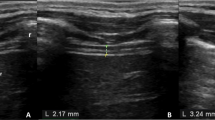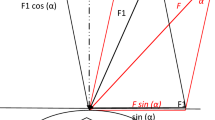Abstract
Introduction
According to Advanced Trauma Life Support (ATLS) for trauma patients, a cervical collar should be applied initially. Patients on backboards with a cervical collar mostly complain of dyspnea and tend to take the collar off or roll themselves off the backboard. The purpose of this study is to investigate the effect of collar removal on lung volumes and dyspnea in patients with GCS 15.
Method
In a physiological study, 50 trauma patients with a GCS of 15 were enrolled. We measured lung volumes before and after the application of a cervical collar in patients.
Results
The average FEV1 in patients with and without a cervical collar was 89.08 ± 17.59 (% of predicted) and 98.26 ± 17.74 (% of predicted), respectively. The average FEF25–75 in patients with a cervical collar was 90.80 ± 26.07 (% of predicted) and in patients without a cervical collar it was 101.90 ± 23.06 (% of predicted). The average FEV1/FVC in patients with a cervical collar was 95.30 ± 18.55 % and in patients without a cervical collar it was 99.14 ± 18.12 %.
Discussion
The FEV1, FEV6, FEV1/FEV6, PEF, FEF25–75, FVC, FEV1/FVC parameters of pulmonary function tests were significantly increased after collar removal.
Conclusion
Cervical collar applications in trauma patients cause a significant decrease in lung capacity and spirometry parameters. Patients suffering from lung diseases and respiratory distress require special attention which means that the cervical collar should be removed as soon as cervical injuries are ruled out so as to avoid hypoxia.



Similar content being viewed by others
References
Taviloğlu K, Ertekin C. Current status and future options for trauma and emergency in Turkey. Ulus Trauma Acil Derg. 2008;14(1):10–3.
Tintinalli JE, Kelem GD, Stapzynski JS. Emegency medicine: a comprehensive study guide. 6th ed. New York, Mc Graw Hill, 2004, pp. 1569–82.
American Academy of Orthopedic Surgeons Committee on Injuries, Fractures and dislocations of the spine. Emergency care and transportation of the sick and injured. Chicago, IL: American Academy of Orthopedic Surgeons. 1971; pp. 111–5.
American College of Surgeons Committee on Trauma: ATLS advanced trauma life support program for doctors. Student Course Manual. 9th ed. Chigago, IL; 2012.
Bernhard M, Helm M, Aul A, et al. [Preclinical management of multiple trauma]. Der Anaesthesist. 2004;53:887–902; quiz 903–4.
Ay D, Aktaş C, Yeşilyurt S, Sarıkaya S, Cetin A, Ozdoğan ES. Effects of spinal immobilization devices on pulmonary function in healthy volunteer individuals. Ulus Travma Acil Cerrahi Derg. 2011;17(2):103–7.
Barreiro TJ, Perillo I. An approach to interpreting spirometry. Am Fam Physician. 2004;69:1107–16.
Bauer D, Kowalski R. Effect of spinal immobilization devices on pulmonary function in the healthy, nonsmoking man. Ann Emerg Med. 1988;17(9):915–8.
Schafermeyer RW, Ribbeck BM, Gaskins J, Thomason S, Harlan M, Attkisson A. Respiratory effects of spinal immobilization in children. Ann Emerg Med. 1991;20(9):1017–9.
Legg SJ, Cruz CO. Effect of single and double strap backpacks on lung function. Ergonomics. 2004;47(3):318–23.
Bygrave S, Legg SJ, Myers S, Llewellyn M. Effect of backpack fit on lung function. Ergonomics. 2004;47(3):324–9.
Totten VY, Sugarman DB. Respiratory effects of spinal immobilization. Prehosp Emerg Care. 1999;3(4):347–52.
Author information
Authors and Affiliations
Corresponding author
Ethics declarations
Conflict of interest
Alireza Ala, Samad Shams-Vahdati, Ali Taghizadieh, Seyed Hasan Miri, Nastaran Kazemi, Seyedeh Robabeh Hodjati, and Mehran Jalilzadeh-Binazar declare that they have no conflict of interest.
Compliance with ethical requirements
Ethics Committee of Tabriz University of Medical Sciences with the No.5/4/6848 approved this study on 21 October 2012.
Rights and permissions
About this article
Cite this article
Ala, A., Shams-Vahdati, S., Taghizadieh, A. et al. Cervical collar effect on pulmonary volumes in patients with trauma. Eur J Trauma Emerg Surg 42, 657–660 (2016). https://doi.org/10.1007/s00068-015-0565-1
Received:
Accepted:
Published:
Issue Date:
DOI: https://doi.org/10.1007/s00068-015-0565-1




